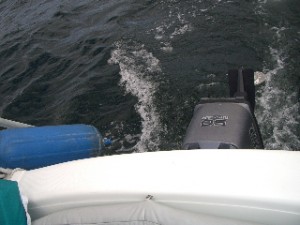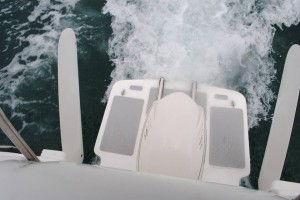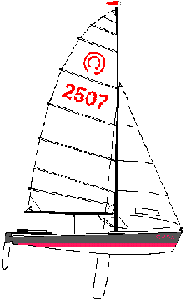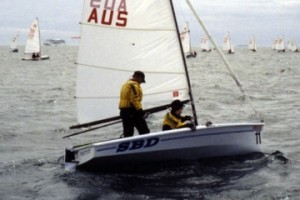The competing hull forms in Murrelet (displacement in the bow and planing aft) bring up some interesting aspects in sailing the cruiser. Because the manufacturer built so many pocket cruisers, the best hull form and ballast configuration was extensively studied.
For example, one contemplated factory modification in 2000, involved adding a platform to the transom which would make the Mac26x power sailer 28 feet overall and perhaps 25 feet at the water line when at a modest heel. (I estimate that Mac26x cruisers are 22 feet at the water line when crew members are sitting aft owing to bow lift.) The swim platform would yield a higher theoretical displacement hull speed owing to the extra feet at the waterline. But it would also prevent the craft from cresting her bow wave at the lower speeds associated with the standard shorter LWL. The contemplated work around involved a platform that could be raised. Hence, when the cruiser was lightly loaded, the platform would not be involved. But when heavily loaded for extended cruising the deployed platform would provide more storage room and give the added benefit of a higher displacement hull speed. (Length at Waterline is also called Load at Waterline.) The photo shows a platform being rolled out as a potential accessory.
 The manufacturer decided against offering the modification owing to concerns regarding container shipping the vessel. Apparently the platform mechanism contemplated would prevent two modified Mac26x cruisers from fitting into one US size train container, hence doubling the shipping costs to dealers. A pallet-wide ocean cargo container will also hold the cruiser on its trailer. A special roller may be required to tilt the vessel slightly. This versatility allows protecting the yacht investment while moving the cruiser to blue water destinations. I was informed by a factory representative that a swim platform for the 26M was planned and that when this is engineered there is a strong likelihood that it will work for the X as well.
The manufacturer decided against offering the modification owing to concerns regarding container shipping the vessel. Apparently the platform mechanism contemplated would prevent two modified Mac26x cruisers from fitting into one US size train container, hence doubling the shipping costs to dealers. A pallet-wide ocean cargo container will also hold the cruiser on its trailer. A special roller may be required to tilt the vessel slightly. This versatility allows protecting the yacht investment while moving the cruiser to blue water destinations. I was informed by a factory representative that a swim platform for the 26M was planned and that when this is engineered there is a strong likelihood that it will work for the X as well.
In any case the MacGregor 26M, introduced in March of 2003, addressed the issue of heavy loading with larger storage compartments. The 26M hull form is V shaped in the stern and the V shape provides additional storage. MacGregor produced 7,000 26X models and 2,000 26M models so comparisons between the hull forms are possible.
Sailing Speed
http://www.eskimo.com/~mighetto/p11.htm is one of many calculators available on the web that are used as the basis of marketing claims regarding sailboats. This one defaults to values for the X. If you plug in values for the M you can state that by the math the M has a slightly higher potential for speed under sail when not planing. Her Sail Area to Displacement ratio is 19.067 and the X SA/D is 18.677. Most of that potential is owing to sail area, however, and in practice crew competency and sea conditions will determine which vessel wins any race. The hull speed for the M of 6.437 is not enough of a difference from the X which is 6.426 for it to be otherwise. Couple that with the finding that the X actually sails faster when reefed in many conditions, and one can conclude that both vessels are dissimilar in regards to powering by sail.
 |
 |
The math shows that both vessels are capable of breaking from displacement speed and reaching a true plane. This is indicated by the displacement/length ratio being under 150. The X is significantly better at planing; her D/L is 137.59 vs the M’s at 145.61. It probably will take abnormally strong wind (20 knots perhaps) for the M to plane fully ballasted where that potential in the X is evident in 12 knot winds, perhaps less depending on the point of sail. The X has a planing Dribbly style hull form. The M has more of a traditional rounded River sailboat form. The marketing material cover picture for the X (left side) shows her on plane; no wave form is visible on her length. The M, (right side) while cooking in good wind, is at displacement speeds as indicated by the wave form on her length. She is also being sailed at a noticeable heel, more like a traditional displacement sailboat. These two pictures portray a vast difference between the sailing styles advanced in the two at-first-glance similar power sailers.
La Perla Noir

Note that the manufacturer intended the 26X to be raced unballasted when that made sense. The 26M was oriented to cruising and wasn’t marketed for racing. The manufacturer intended the 26M to be operated unballasted only when motoring at planing speeds capable of pulling a water skier. To fit that purpose 300 lbs of solid ballast was fitted into each 26M and the water ballast tank size was reduced a like amount in comparison to the 26X so that both powersailers could carry 1,400 lbs of internal ballast. This allowed one of the dealers to test the desirability of external foil mounted ballast.
Rendezvous 2005: Huzzah, La Perla Noir!
On Thursday June 16th three Mac26x cruisers (the triple X fleet) joined the 2005 MacGregor Rendezvous. We were unable to catch the Elliot Bay MacGregor fleet but were able to meet the Pearl with them during the dog watch at Port Orchard.
The Rendezvous Not Quite Race was held on Saturday June 19th. Two of the triple X boats were honored with wine glasses for their fast times around the marks but neither would challenge the Pearl when she hoisted sail to join the fun. Instead the cameras started clicking. Huzzah, La Perla Noir! For God, Country and the prize. The Pearl was fitted with a retractable bulb keel foil. The 300 lbs of solid ballast that the manufacturer put in her sister ships was absent. The Pearl has a 430 pound lead bulb hanging on the bottom of a dramatically reinforced daggerboard. The daggerboard weighs 77 lbs, so the total package is just over 500 pounds. We wondered if the Pearl sailed that day without water ballast. Likely she used water ballast like the rest of us. The bulb keel shape was like a torpedo. One aspect of sailing with a bulb fin keel is that the optimum shape is dependent on speed through the water.
How much faster is the Pearl under sail than a stock boat?
Boy, that’s tough to quantify this early in the program. The short answer is A LOT, by sailing without ballast, the boat is about 1200# lighter than a stock boat, and weight is almost always the enemy. We are still fine tuning, learning, and changing things, not to mention that we don’t even have the proper spinnaker yet, so she keeps getting faster..
In timed tests on Lake Union the Pearl has been around 50 seconds per mile faster upwind in light to moderate breeze without water ballast than a stock boat with ballast, and 70 or 80 seconds per mile faster downwind in the same conditions, and that was without spinnakers on either boat, so we would expect a much bigger difference if we had the advantage of the much larger spinnaker!
So far it seems that the biggest performance improvement upwind may actually be in stronger winds. Under these conditions we sail with the keel down AND water ballast, making the boat VERY stiff. We have sailed in about 18Kts of breeze on Puget Sound with the ballast full and the boat was going to weather like a freight train! Fast, stable, and really easy to sail, we were easily able to sail away from boats that we know we would have had trouble beating in a stock boat. We did a horizon job on a San Juan 24 in about 45 minutes!
– Todd
There were almost as many positive flotation power sailers at the rendezvous and race as there were at the J24 Nationals, where several capsized in 20 knot winds and one sank. No compromise on safety with a MacGregor yacht. The 26M and 26X both have solid flotation that makes the float even when capsized.
BZBWY: US Navy Code for Well done Blue Water Yachts.
FROM THE La Perla Noir HOME PAGE
“The Pearl” (Now Known As “ROZ”) Has Moved On To a New Home, You may See Her Cruising Northwest Waters Based Out Of Olympia, WA!

La Perla Noir SAILING UPWIND IN ABOUT 14kTS WITHOUT WATER BALLAST
La Perla Noir (more commonly known as “The Pearl”) was envisioned as the ultimate development of the 26M. We set out to achieve new highs in luxury, performance and cruising comfort and she has exceeded even our highest expectations. She offers a customized interior with features such as dimmable recessed lighting, custom storage options, refrigeration, and Teak and Holly flooring. With the combination of her retractable keel and water ballast, she provides the stability and sailing performance of a 30 foot keelboat, yet she is still trailerable and can motor at 20MPH, truly the best of several worlds!! Many of the modifications to this boat are one of a kind and building another like her is not an option.
Ocean Passage Hull Form
By the math, both the 26X and 26M are ocean passage sailboats. There is no significant difference in the capsize risk ratio (X = 1.94 vs M = 1.91). Both are solidly under 2 which is the cut off point defining an ocean worthy cruiser and the ratios only improve when the boat is loaded for passage making. The M does not have as good a ballast/displacement ratio (M= .3615; X = .3722) meaning that the X is slightly more stable than the M when unloaded.
 The X hull form appears to be similar to the Tasars which are the advanced form of the Dribbly hull. If the X hull is also the Tasar/Dribbly hull then there are characteristics known to apply. These include sailing faster than river hulls (like the M) in the chop of a harbour or around a crouded racing bouy. It also puts X vessels into a traditional hull form from 100 years ago as well as the truely modern Tasar form. See
The X hull form appears to be similar to the Tasars which are the advanced form of the Dribbly hull. If the X hull is also the Tasar/Dribbly hull then there are characteristics known to apply. These include sailing faster than river hulls (like the M) in the chop of a harbour or around a crouded racing bouy. It also puts X vessels into a traditional hull form from 100 years ago as well as the truely modern Tasar form. See
http://www.cs.stir.ac.uk/~kjt/sailing/tasar/tasar.html
and http://www.macgregor26.com/drawings.htm
The first refers to the current form of the Dribbly hull (see drawing) and the second is the Mac26x cruisers. Frank Bethwaite in High Performance Sailing page 248 states…The fourth (Dribbly) hull was designed in 1969 by Mark Bethwaite, and was the beginning of the truly modern stream.. he designed a boat with a long fine entry forward, and a long flat run between wider and almost parallel chines aft. When I watched it take shape I reflected that there is little new in this world. I recalled the ‘cod’s head and mackerel tail’ that English Bristol Channel pilot cutters developed through the nineteenth century, which had the same asymmetric ‘deepest forward and widest aft’ general shape (fig 20.2).
 The 26X is meant to be sailed flat, with stability and balance coming from the flexible (also called soft) rigging as well as centerboard positioning. She gets most of her power from the head sail. The M uses a roached and powerful main and has a harder rig. The headsail is far from a source of power. The M mast rotates (like a Tasar or multi hull mast) to take advantage of the power in the mainsail while pointing. The 26X’s centerboard jibes to windward to provide better pointing. The 26M uses a wide daggerboard foil rather than a high aspect ratio swinging centerboard foil. These are very different pocket cruisers requiring very different sailing styles for reaching speed potential. Nonetheless both are ocean sailboats rather than protected bay and lake sailboats.
The 26X is meant to be sailed flat, with stability and balance coming from the flexible (also called soft) rigging as well as centerboard positioning. She gets most of her power from the head sail. The M uses a roached and powerful main and has a harder rig. The headsail is far from a source of power. The M mast rotates (like a Tasar or multi hull mast) to take advantage of the power in the mainsail while pointing. The 26X’s centerboard jibes to windward to provide better pointing. The 26M uses a wide daggerboard foil rather than a high aspect ratio swinging centerboard foil. These are very different pocket cruisers requiring very different sailing styles for reaching speed potential. Nonetheless both are ocean sailboats rather than protected bay and lake sailboats.
The selection of a chined or round bilged hull form is often not a clear cut choice and a number of competing factors need to be considered. For grand-prix offshore focused designs like the Volvo 65’s, Volvo 70’s, IMOCA 60’s, Class 40’s etc. we are seeing designs that approach or even exceed the power to weight of the highest performance dinghies [18’ skiffs, i14’s …]. These designs spend a lot of time in the planing boat zone so considering powerboat and skiff-like features such as chines makes a lot of sense.
Britt Ward in SA blog post , Farr Yacht Design.



4 thoughts on “Competing Hull Forms Bethwaite”